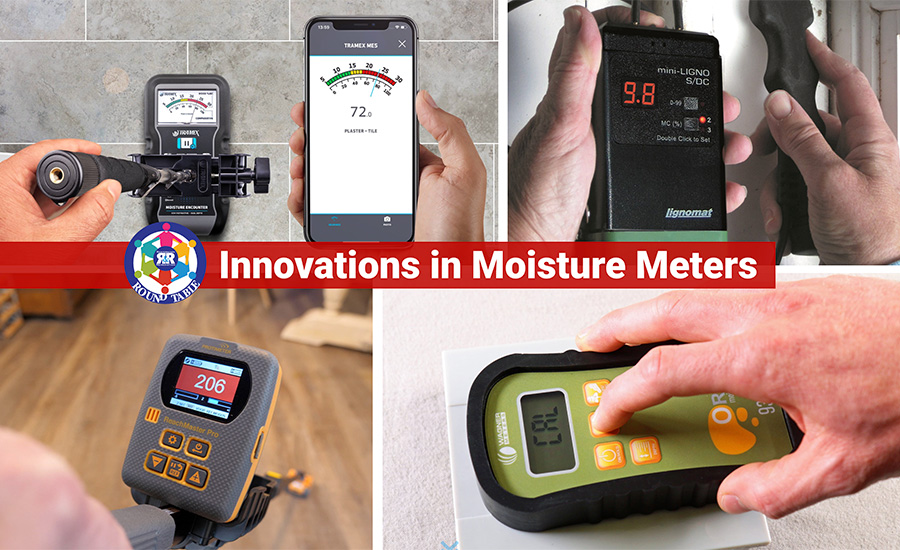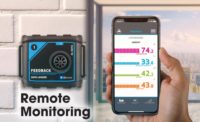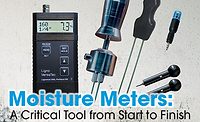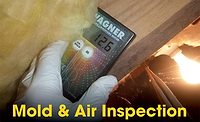R&R Roundtable
Innovations in Moisture Meters

Editor’s Note:
Editor’s Note: One of the best ways to make an educated buying decision is hearing information right from the experts, then assessing that information to make an educated decision. In this R&R round table, four product experts discuss the latest in moisture meter technology.
Panelists

Grete Heimerdinger Vice President Lignomat USA
Grete Heimerdinger was a science teacher in Stuttgart, Germany, before moving to the United States. She has been vice president of Lignomat USA for the past 30 years. Along with being actively involved in product development, she is a member of the ASTM task groups C11 for measuring moisture in gypsum, and ASTM F-2170 for measuring moisture in concrete.

Tom Rochenski National Sales Manager Protimeter
Tom Rochenski is the national sales manager for the Protimeter brand of handheld instruments. He has been in the disaster restoration industry for over 15 years. He travels the country selling, educating, training, and supporting distributors and contractors with the Protimeter line of hand held instruments. His main industries of focus include disaster restoration, commercial flooring, and home inspection.

Andrew Rynhart CEO Tramex Ltd.
Andrew Rynhart is the CEO of Tramex Ltd. For more than 40 years, Tramex has been an international leader in design and manufacturing of moisture and humidity meters and dataloggers. Andrew is from the second generation of Tramex as his father was the founder of the company and so he grew up around moisture inspection in the building envelope. Tramex’s heritage in innovation began with its foundation in 1974. Inspired by their experience and knowledge of building moisture inspection, Tramex invented, patented, and developed the first ever non-destructive moisture meters.

Jason Spangler Sales Manager Wagner Meters
Jason Spangler, Wagner Meters’ Sales Manager, has more than 25 years of experience in sales and sales management across a broad spectrum of industries. He has successfully launched a variety of products to the market, including the original Rapid RH® concrete moisture test. Jason, who received an MBA from West Texas A&M University in November 2018, has extensive industry involvement, including the National Wood Flooring Association (NWFA), the International Certified Flooring Installers Association (CFI), and is Vice Chairman of Associations for The Flooring Contractors Association (FCICA).
1. Why do moisture meters remain a key tool for restorers in 2021?
Heimerdinger: Very simply put, they are important when moisture is present. Many materials used in the building envelope react to moisture in the air or other water infiltration (rain, flood, etc.) by absorption or loss of moisture. There are consequences for too much moisture. The danger of mold growth is looming if too much moisture is present. Mold will grow anywhere if the substrate contains carbon, high moisture content in materials, and oxygen in air. Main issues about mold: Mold destroys the material it grows on and it produces spores which circulate in the air and can be very bad for humans. The other side of moisture is particularly important for wood: if wood moisture changes, wood expands or shrinks, which can lead to ugly visual defects.
Rochenski: Moisture meters are very important when assessing moisture on a restoration job. Not only do they give you relevant moisture readings but they also allow you to moisture map in most cases to the area of the water intrusion. They tell the technician when the job is dry and when they can reposition or remove the drying equipment.

Photos credit: Lignomat USA
Rynhart: Any moisture left in a building after water damage restoration can lead to major issues including damage to building structure and materials, as well as indoor air quality issues due to mold. A good quality moisture meter is an essential tool for any restorer in 2021, especially with sufficient training to be able to use it correctly and optimize the interpretation of the moisture readings. It is important to note not all moisture meters are designed for building inspection. Choosing a moisture meter that has been designed and calibrated with specific scales to measure and evaluate moisture in a wide range building materials will be of the most benefit to the restorer.
Spangler: When damage occurs to a residential or commercial structure, excess moisture is often the culprit. For example, the National Wood Flooring Association and other industry experts have estimated that at least 75% of all flooring failures are the result of moisture issues. Using a moisture meter provides a quick, easy, reliable, and inexpensive way for a restorer or remediation specialist to conduct a moisture assessment. Then, they can pinpoint the locations where moisture may be lurking in walls, floors, and ceilings.

Photos credit: Lignomat USA
2. What are the main 3 things new technicians should be trained on when it comes to accurately using a moisture meter?
Heimerdinger:
Pin meters measure the electrical resistance between two metal points, to pinpoint moisture to a small area. Pinless meters measure the capacitance in a field. Wherever the meter is placed, they give an average of the field.
Measuring relative humidity helps determine moisture conditions in the building envelope. Next, they need to know all materials have material-specific characteristics, which affect the measurements. For accurate readings, the meters need to be corrected for the material to be measured: wood, drywall, panels, etc. If the material correction is unknown, meters can still be used, and will indicate wetter and dryer places. If a dry sample piece is available, they can be used to check which areas are ok and which have higher moisture.

Photos credit: Protimeter
Rochenski:
New technicians need to be able to tell the difference between what building material is truly wet and what might be considered a false positive reading. The false positive readings are generally when the meter comes into some type of contact with metal. Metal, like water, is very conductive and will give a false reading of moisture being present.
New technicians should be aware of the depth of the meter. Most quality meters on the market will only read to a depth of ¾ of an inch below the surface. When in pinless mode, it is giving you a relative reading of moisture, not a percentage of moisture. Pins are generally more accurate and will give you a true percentage of moisture in the building material.

Photos credit: Protimeter
New technicians should be aware of surface condensation on building materials. This should not be confused with moisture saturation. Some meters will give a high reading even if the moisture is only on the surface.
Rynhart:
Understanding the difference between qualitative and quantitative measurements is a key point when testing and interpreting results. Qualitative or comparative measurements are essential for understanding the moisture condition of the building, finding the extent and spread of the moisture infiltration, as well as locating the possible source of any leak. Quantitative measurements are required for the reporting of that information, before, during, and on completion of the drying procedures. Without understanding the distinction between qualitative and quantitative measurements, it is not really possible to use moisture meters correctly.

Photos credit: Tramex Ltd.
How to establish "dry standard" readings, (sometimes called base-line) and how to use them for moisture mapping is key to getting the most from a moisture meter for building inspection.
How to identify and eliminate false positive readings and how to avoid false negative readings allows the user to correctly ascertain and report the moisture condition of the building without inaccuracies or misinformation. False positive readings are the friend of a restorer if they can be identified and eliminated from being interpreted as high moisture. False negatives are the real enemy, though, as they can lead to moisture being left unidentified and unmitigated, leading to ongoing damage to buildings and indoor air quality issues.
Spangler:
Know how to check that the meter is properly calibrated. A meter that is not calibrated to factory specs will not give accurate readings. If you find the meter is not calibrated, at least one brand of moisture meter comes with a calibration block that allows you to recalibrate the meter back to factory standards in the field.
Know how to use the meter’s settings functions for the type of material (i.e., wood, drywall, etc.) being measured. If you are measuring the moisture content of wood, you will also want to know how to set the meter for the correct species of wood in order to ensure accurate readings.
Know how to place or orient the meter for correct readings. If using a pinless meter, it is important for the sake of accuracy that the sensor plate on the meter makes firm and full contact with the material being measured. If using a pin-type meter, know which way to orient the pins relative to the grain of the wood.

Photos credit: Tramex Ltd.
3. What are some of the common mistakes you see restorers making when taking moisture readings?
Heimerdinger: I think placing a moisture meter and looking at a value is easy. And if instructions are followed, it is easy to get a measured value. The hard part is to judge what the value means in a specific situation. Again, technicians need to know to interpret the readings correctly. It also requires some understanding of the situation to find the right spot to take a reading. If the problem is in the wall, the wall and all adjacent areas need to be measured, since moisture migrates. The technician needs to be aware that a leaking roof can cause trouble at the bottom of the wall.
Rochenski: As I previously mentioned, a major mistake is when the meter comes into contact with a metal material behind a wall. This could be metal corner bead, pipes, HVAC ductwork etc. Another common mistake is not establishing a “dry standard”, meaning a good restorer will take moisture readings in an unaffected area. Record those readings and use them as a baseline for drying out the affected area. Simply stated ,the wet area readings should be close to the dry areas (baseline) when the drying job is complete.
Rynhart: One of the most common mistakes made when taking moisture readings is in misunderstanding the distinction between qualitative and quantitative testing measurement and when each should be applied. A major part of the work of a restorer is to qualify that materials have been dried back to their pre-loss condition. Since the quantitative pre-existing moisture level is not often known, it is essential to use qualitative measuring in the most effective way possible with a quality moisture meter that allows for repeatability and consistency in its readings.
Spangler: One common mistake is to use a handheld moisture meter intended for taking surface readings (to a depth of less than one inch) when evaluating moisture in concrete, such as after flooding has occurred. This might be deemed an acceptable method for an insurance claim, but it creates something of a disconnect for any flooring repair or replacement work. In many cases, a lot of moisture may be “hidden” below the surface of the slab. If excessive, this may lead to a flooring failure. The best method for evaluating the moisture condition of a concrete slab is the in-situ relative humidity (RH) test using an RH concrete moisture test kit.
4. What innovations have you seen in moisture meters in the last year or so? And on that note, what innovations do you see on the horizon?
Heimerdinger: The latest addition I think were the infrared cameras. I have not seen innovations in moisture meters, at least not in the measuring principles, but there are always innovations to make meters easier to use - including reaching hard places and logging data.
Rochenski: Bluetooth technology is starting to become more common in moisture meters. This allows the restorer to save the readings either internally in the meter or download them to an app. Also, some new moisture meters are able to read much deeper than traditional meters. There is a meter on the market called the ReachMaster Pro which will read, depending on the density of the material, up to five inches below the surface.
Rynhart: Although dual-depth functionality is not an entirely new concept, the latest technology used in the most recent moisture meters now have such precision and accuracy in the shallow-depth scale, that these non-destructive readings are comparable to actual pin readings. Non-destructive, shallow depth penetration also allows for the elimination of substrate influence when testing the moisture conditions of the coverings, and greater accuracy and precision of the readings within the coverings. Using the dual-depth functionality by switching between the appropriate regular depth scale and shallow depth scale, allows for a comparative of surface moisture readings versus surface + core moisture readings so as to obtain a comparative of moisture conditions both within the materials and within and behind the materials. Also, the Tramex Meters app has been designed specifically for use with building material moisture meters and the water damage restoration industry. The app enables better visualization of live readings and reporting data from all Tramex Bluetooth devices. Photographs of the meter in the testing location can be taken, showing the time-stamped moisture readings. It is possible to geo-tag images, providing vital supportive documentary evidence for the moisture measurements and readings.

Photos credit: Wagner Meters
Spangler: One very significant innovation has been the integration of Bluetooth, so that moisture readings can be seamlessly transferred to a smartphone or other mobile device for easy access to all your data. This saves time and eliminates the potential for human error when transcribing data by hand. The Orion 950 by Wagner Meters is an example of a handheld meter that utilizes Bluetooth technology for recording readings. Looking ahead to the future, the meters in greatest demand and the most successful companies will be those who keep up with the technological changes and the digital advancements that will occur.
5. What are two or three qualities restoration contractors should be looking for in a good, reliable moisture meter?
Heimerdinger: Meters need to give reproducible results; results should not depend on the person using the meter, but on what is measured. They should be easy to use and easy to read. Big display numbers. Accuracy should be confirmable with an outside-the-meter external check block.
The meters also need to be able to withstand the harsh environment of the restoration site, and the meter's range should be wide enough for dry and wet materials.
Rochenski: Accuracy and durability are by far the most important qualities when purchasing a moisture meter. For ambient conditions, look for fast-acting sensors and an accuracy of at least +/- 2% for the relative humidity readings. Also, look for meters that have multiple functions to them. There are meters available that do both pin and pinless in one meter. Also there are 3-in-1 meters that do pin, pinless, and all hygrometry functions. A manufacturer's experience in respiration can be invaluable as well as a warranty of at least two years.

Photos credit: Wagner Meters
Rynhart: Aside from the obvious benefits of a robust and durable meter that will stand the test of time and frequent use, a very important quality to seek out is the repeatability of readings. A reliable moisture meter is one that is easy to use and that gives the consistent readings, regardless of who is using the meter. Good repeatability of readings allows for meaningful comparative analysis of moisture conditions throughout the drying process, as well as across teams of water damage restorers. A quality moisture meter is one that allows for accurate testing of moisture conditions of large areas in the shortest possible time. The footprint of the moisture meter should allow for this. A handheld dual-depth Tramex moisture meter allows for both accurate and fast non-destructive readings over large areas, as well as non-destructive precision comparable to actual pin readings.
Spangler: The most important factor is that the meter is capable of giving accurate moisture readings. A meter won’t be particularly useful if it is not accurate. In general, you get what you pay for. This means you should steer clear of inexpensive meters and opt for meters from brands like the ones you see represented here, and a few select others.
Moisture meters come in two basic types: pinless and pin. In most cases, a pinless meter will make the best choice for a restorer because it is well-suited for quickly scanning a large area for moisture. Plus, it won’t leave unsightly pinholes.
It is also important to consider if the meter will be comfortable, easy-to-use, and durable. Some questions to consider: Is the display large enough and bright enough to read easily? Is the meter compact enough to fit in my pocket? Does it come with its own case? Does it appear to be well-made so that it will stand up to rugged, daily use? Does it come with the built-in features that I want?
6. Anything else?
Heimerdinger: Read the manufacturer's instructions on how to use a moisture meter and when that does not answer all the questions, call the manufacturer or the place of purchase to clarify.
Rochenski: Don’t buy cheap meters. They will only break down when you need them the most. Look for meters that have field replaceable sensors for ambient readings. Always try and keep your meter at room temperature whenever possible. This will greatly reduce the time the meter need to acclimate on a job site. For example, if you leave multifunction meter in a cold or hot car overnight. It will take longer for the meter to give accurate temperature readings because the meter needs to come to room temperature.
Spangler: One vital thing to emphasize for the restorer or remediation specialist is to develop a good relationship with the manufacturer of your moisture meter. That way, they can help you understand the proper usage of your meter and aid in making the best choice of meter for your application.
Looking for a reprint of this article?
From high-res PDFs to custom plaques, order your copy today!








